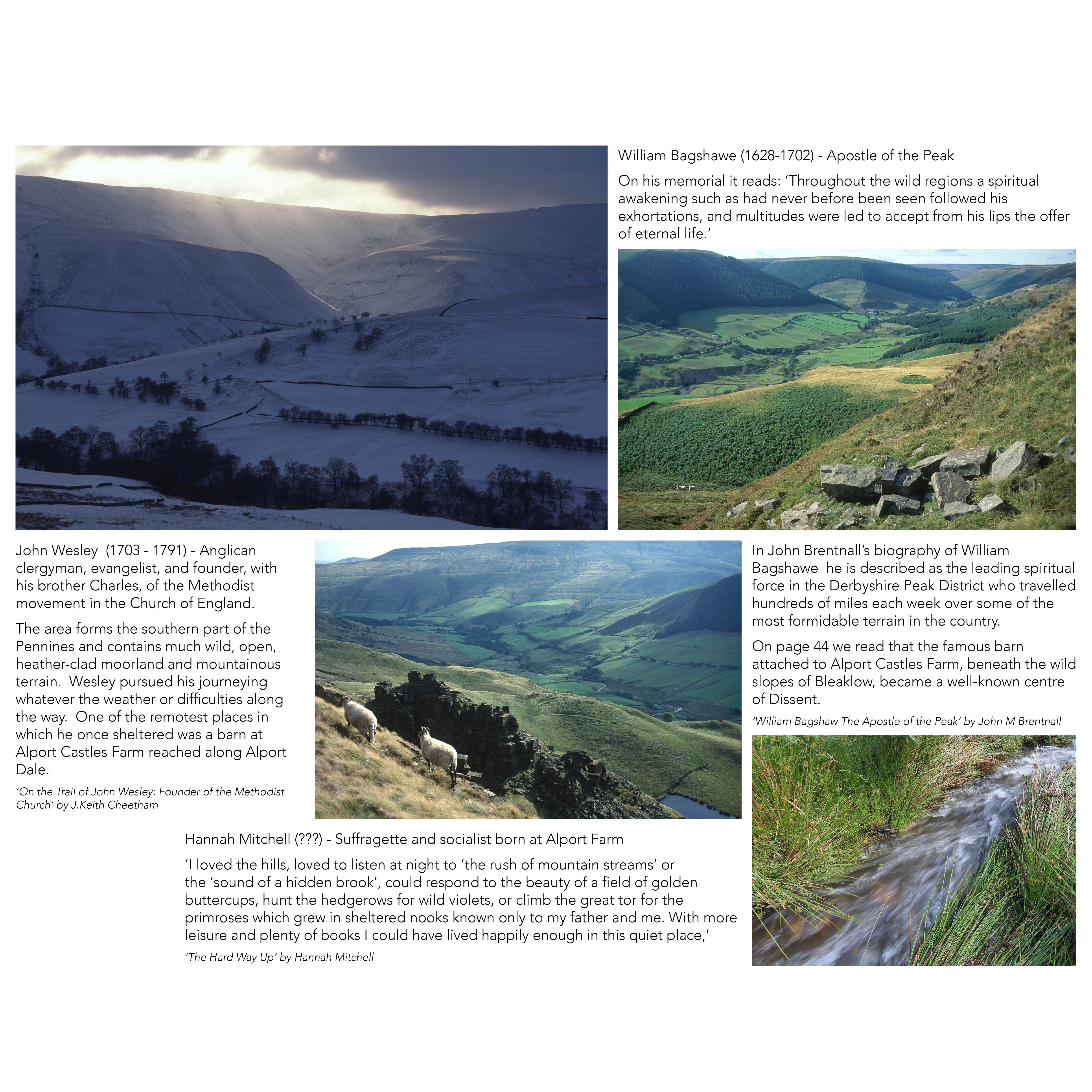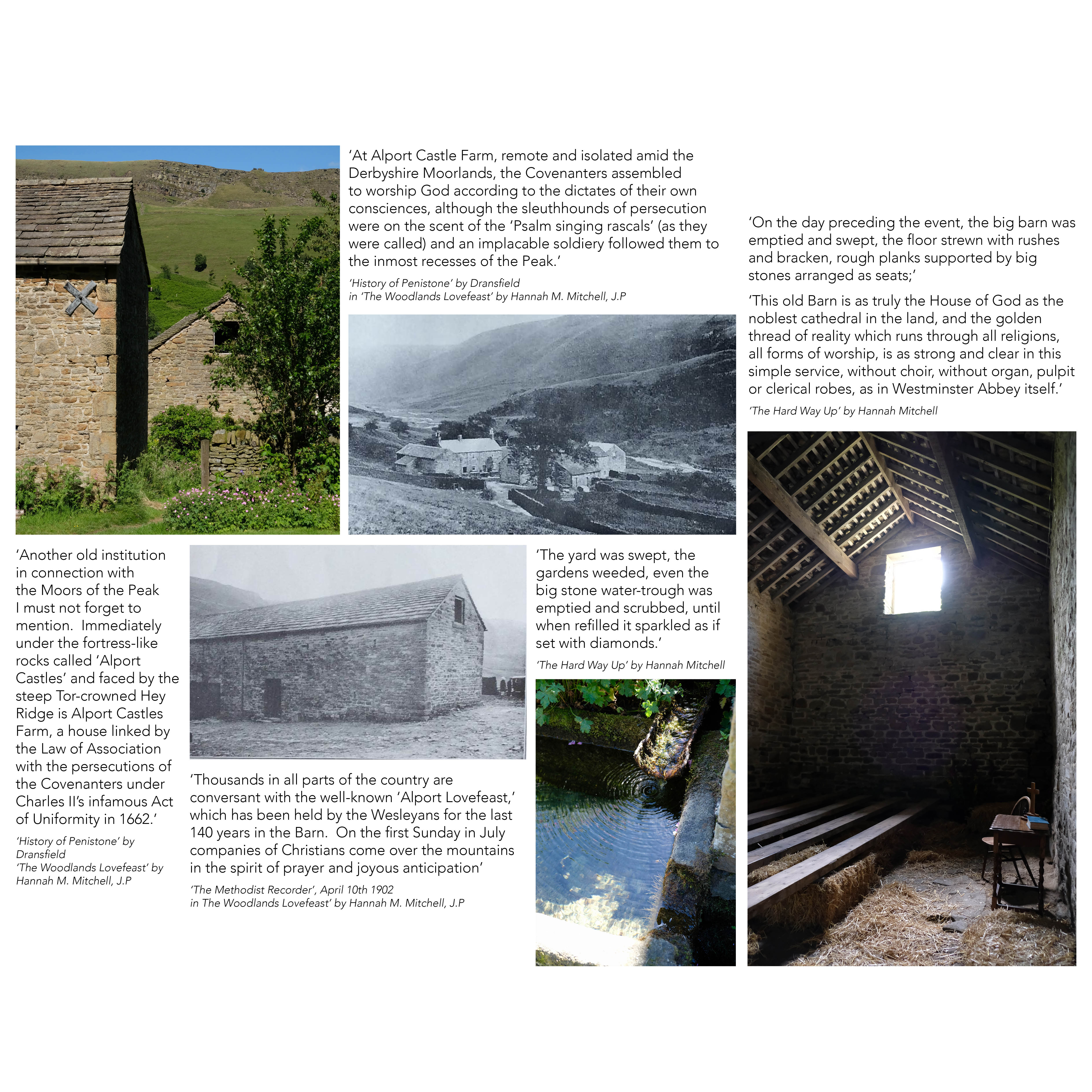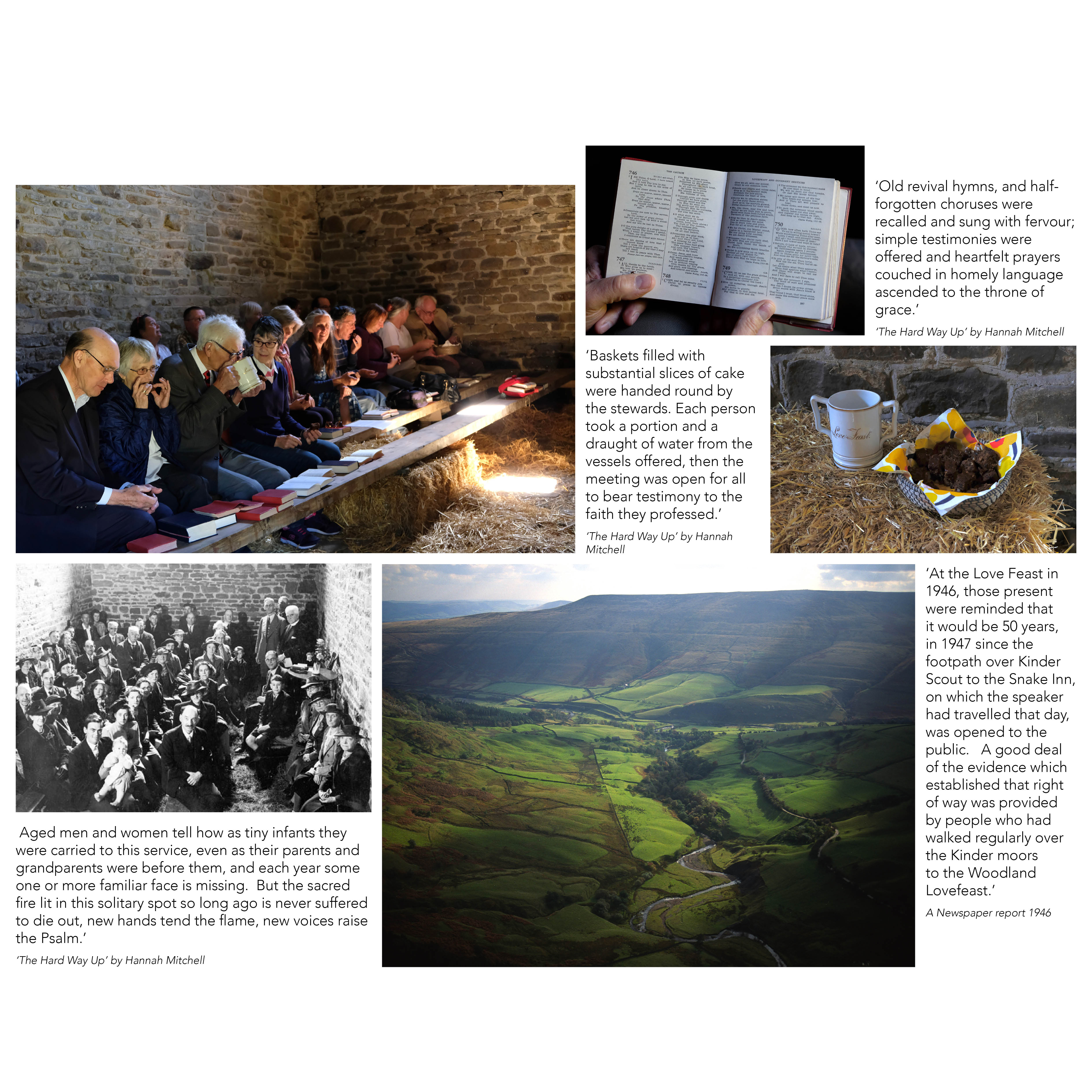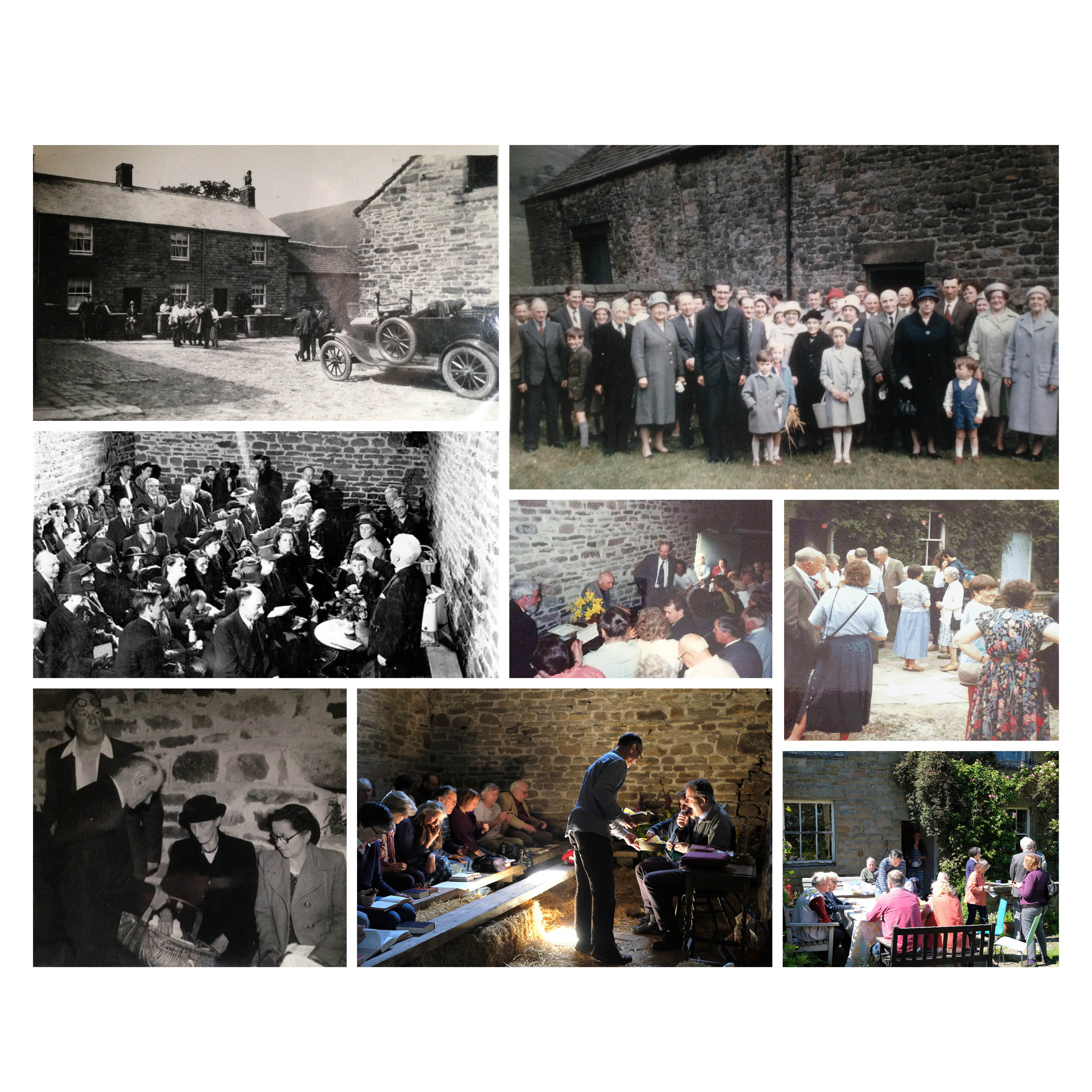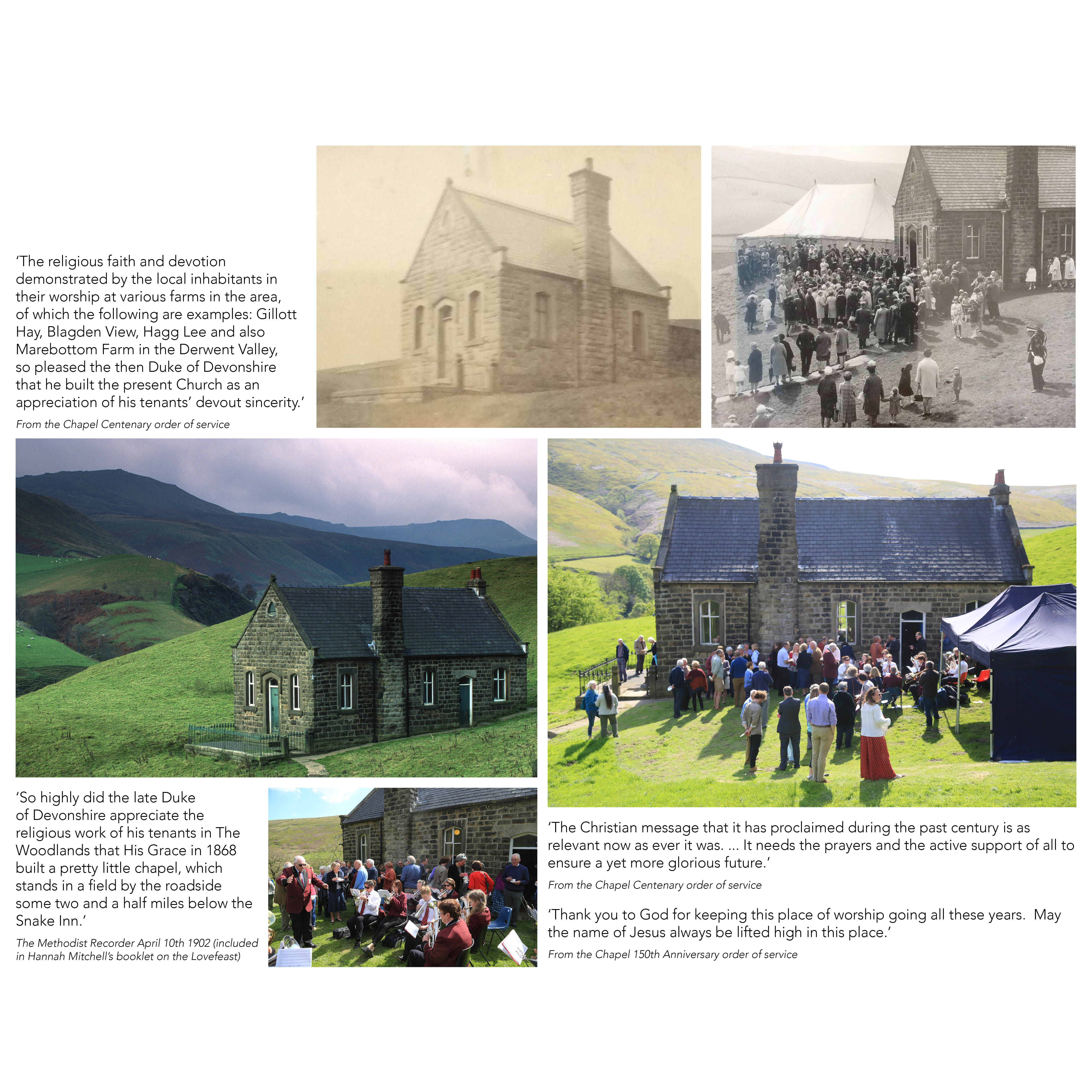As we are approaching another Lovefeast, and I have been posting regularly on Facebook, I realised that I hadn’t posted on the blog for a long time – a whole year! Whilst looking back at documents that we gathered together last year, I reread the text that Jennifer Fox wrote for us for a slide show that was part of our fund raising activities for renovations in 2010-2011. We are actually considering extending this work to make Chapel more accessible and are looking into the possibility of having a loo and improving the path.
Jennifer has been our circuit steward for 10 years and is retiring this year. We are very grateful to her for her support and friendship.
I thought people might be interested to read the history that she prepared at that time.
WOODLANDS METHODIST CHURCH Research by Jennifer Fox
Before the Chapel was built (SLIDE Map)
John Brentnall writing about William Bagshawe, the Apostle of the Peak gives Alport Castles as a place associated with Bashawe’s ministry 1662 -1702.
SLIDES Love-Feast
Alan Ogle in his articles about Methodism in the Peak says “there is a tradition that John Wesley on his journeys sometimes preached at Alport Castles Farm. As the old bridle path from Yorkshire passes through the farm yard and the farm itself was a house of call for travellers this seems a possibility.
What is known is that from the early 1760’s an annual Methodist Love-feast has taken place in the barn on the first Sunday in July. The Love-feast (originally called an “Agape”) goes back to the early days of Christianity. It was revived by the Moravians and by the early Methodists.
The meeting is informal and consists of prayer, praise and fellowship. Bible passages are read and those attending often contribute other readings. Some speak of what their faith has meant to them and of their Christian experience. Favourite hymns are sung unaccompanied. Pieces of rich fruit cake are passed round in a basket. Two traditional old two-handled Love-feast cups filled with water are also passed round.”
SLIDES of FARMS & SNAKE INN
Seth Evans, in the Methodist Recorder of 1902 writes “This wild district has produced many good champions of the Cross, such as John, Joseph, Jonathan and Isaac Longden. John Longden kept the Snake Inn and held prayer meetings in the public house. One Sunday in 1812 being planned to preach at Tideswell, fourteen miles distant, finding that nearly all his congregation had gone to see a poor fellow hang in the gibbet several miles away, he followed, and preached to the multitude beneath the gibbet post. Another time a bridge over the river Derwent in the Woodlands, collapsed and killed several men whose bodies were removed to the nearest farm house, which was on our plan as a preaching station. As they lay in the dwelling, Mr Longden preached a special sermon from Christ’s words in reference to the Tower of Siloam, ‘Think ye that these men were sinners above all men?’ Its powerful effect was marked by converting power in the crowded company gathered beneath the roof under such solemn circumstances”
According to the earliest evidence available in a preacher’s plan of 1824, there were societies in the Bradwell Wesleyan Methodist Circuit at Gellet Hay and Hag Lee. (The Bradwell & Bakewell Wesleyan Circuits amalgamated in 1905 to form the North Derbyshire Mission Circuit. In 1944 this in turn amalgamated with the Bakewell ex-Primitive Circuit to form the Peak Methodist Circuit.)
A Wesleyan Methodist Circuit Plan of 1858-9 shows that Gillott Hey, Hagg Lee and Alport Farm were used as preaching places. “Most of the Woodlands farmers were tenants of the Duke of Devonshire. He was so impressed by their religious faith and sincerity that he built them the chapel. It was their decision that the chapel should be affiliated to Methodism.” (Alan Ogle)
SLIDE “Woodlands Wesleyan Methodist Chapel erected in 1868 by His Grace the Duke of Devonshire. Work done by his tenants and others” (The building accounts book)
SLIDE The names of the men who worked on the building, carting materials etc
Isaac Longden Jonathan Eyre Samuel Shaw John Bridge George Eyre Benjamin Dawson Jonathan Wilcockson David Allott John Walker John Allott Robert Littlewood John Longden John Thorp Henry Eyre Aaron Bradbury Jonathan Cotrel William Walker Benjamin Ashton Frank Hall
The stone was obtained from Ladybower and Moscar, the slate from Glossop and the pulpit and forms from Castleton. Example: Isaac Longden -ten days with one horse and man at 6s per day paid £3.0.0
SLIDE “Woodlands at a meeting held in the chaple May 16th 1871 it was agred to pay to ceep the chaple in repare” (spellings as written)
Accounts for 1871/2
£ s d
G A Eyre 10 0
Mr J Longden 10 0
Mr Jonathan Eyre 10 0
Mr David Allott 10 0
Mr John Bridge 10 0
Mr John Allott Sen. 10 0
Mr John Allott Jun. 5 0
Mr John Wilcockson 10 0
John Walker 10 0
Mr V H Eyre 10 0
PAID 4 15 0
John Bridge began to clean the chapel May 16th 1871 at 1s /week for one year
£ s d
May 16 John Bridge for cleaning chapel 11 weeks @ 1s per week 11 0
2 books 10
June 17 Painting 9 0
Jan 13 1872 Jonathan Eyre one load coal 9 6
Candles 2 0
John Bridge Chapel cleaning 2 12 0
Bars and Ale ?? 2 3
4 6 7
Balance in Hand at Feb 24th 1871 7 1/2
PAID 4 5 11 1/2
COLLECTED 4 15 0
May 14th 1872 George A Eyre Balance in Hand 9 0 1/2
It appears that the Members agreed to pay the cost of running the chapel equally between them.
As shown above in 1871 most were giving 10 shillings a year, these are the amounts they each gave to the Treasurer in subsequent years
SLIDE
1881 9s
1882 15s 4d
1883 9s
1884 £1 4s 0d
1886 £1 1s 4d
SLIDE Expenditure in 1883: £ s d
G A Eyre Chapel keeping 2 12 0
New flue 2 2
Mr Shaw bill for Harmonion 2 8 0
Mr Leming Sallary 15 0
J P Hunter 71/2 yd Matting @ 1/8 12 6
Himbook binding 1 6
15 cwt coal and ale 9 0
17 cwt coal and ale 9 10
SLIDE Given to Charles Bridge for playing the “Armoin” in May 1876 – £1 15s 0d
G A Eyre 10s and I Longden,, V H Eyre, D Allott, J Allott and J Eyre 5s
SLIDE Members of the Chapel in 1870 and where they lived
There were 15 members in 1868 when the Chapel was built & 21 members in 1870
They each paid Class money of 1d per week to Bradwell Circuit)
Jonathan Eyre, Sarah Eyre Alport
Martha Buttress Alport
Elizabeth Ann Eyre, Hannah Eyre Alport
Isaac Longden, Elizabeth Longden Upper House
Hariatt Allott, Mary Allott Wood
John Wilcockson, Ann Wilcockson Blagden View
George Eyre, Henry Eyre, Sarah Eyre Gillott Hey
John Allott Lockerbrook
John Bridge, Hannah Bridge Bell Hagg
Robert Littlewood, Mily Littlewood Hagg Lee
John Walker Elmin Pits
Jane Hall Elmin Pits
“There were 235 people living in Hope Woodlands on the 1871 Census”
SLIDE The Society Steward’s Account book from March 1912 to March 1920 shows that membership varied from 18 to 22. Society Stewards during this time were Jonathan Eyre and Benjamin Longden.
The Ministers were: 1912 – 13 Revd W Fiddian Moulton
1913 – 19 Revd H Stanley Sandford
1919 – Revd Frederick Inwood
SLIDE North Derbyshire Mission Plan & Directory 1908 (Show actual copy?)
Society Stewards – Mr Jonathan Eyre Mr Benjamin Longden
Poor Steward – Mrs B Longden
Sunday School Superintendent – Mr John Allott
Chapel Stewards- J. Eyre and Isaac Longden
The plan of Preachers’ appointments shows that services at Woodlands were at 2.30pm on Sundays and 7.30 pm on Wednesdays.
John Allott (Woodlands) & Charles Bridge (Ashopton) were listed as Local Preachers
SLIDE Woodlands Members 1923 & where they lived
Jonathan Eyre Alport
Isaac Eyre ‘’
Mary D Eyre ‘’
Annie Eyre Gillott Hey
Mary Webster Snake Cottage
Elizabeth Eyre Hayridge
Emily Eyre ‘’
Ann Eyre ‘’
Benjamin Eyre ‘’
Alfred Longden The Hagg
Ellen Longden ‘’
Thomas W Gee Rowlee
Mary H Gee ‘’
Sarah E M Gee ‘’
Annie Isobel Gee ‘’
Mabel Ollerenshaw Blagden View
Total number of Members 16 Steward Alfred Longden
By 1928 there were 10 members
SLIDE The Receipts and expenditure account book 1912-1920
“ This book is the property of the Trustees & Sunday School Teachers of the Woodlands Wesleyan Chapel and contained a list of provisions required for the Teas also financial account of all Xmas teas & entertainment since Xmas 1910” (as written)
SLIDE
List of Provisions and Confectionary required for the Teas
16 lbs ham
2 tins tongue
5 lbs best butter
10 lbs lump sugar
1 ½ lbs tea
½ lb coffee
8 lbs cake or slab 2 sorts
4 sandwiches cake
4 sponge moulds
3 currant moulds
4 doz assorted cakes
3 ½ doz currant & plain tea cakes
2 fruit loaves
2 seed loaves
1 lb queen cakes
SLIDE Receipts Xmas 1910 £ s d
Tea first day 2 15 0
taken at the door 11 0
Tea second day 12 6
Sale of Provisions 18 3
4 16 9
Subscriptions towards tea s d
Miss Eyre 2 6
Miss Buxton 2 0
Mrs B Eyre 3 0
Mr Willis Bridge 4 0
Mr Jon Eyre 5 0
Miss Beckett 2 6
Mr B Longden 5 0
Mr I Longden 5 0
Mr A Longden 3 6
1 12 6
6 9 3
To Cost of Provisions from A F Hancock Ltd 3 0 8
balance 3 8 7
Cream given by Mrs Peter Eyre & others Bread given by John W Longden
The Chapel was continually updated. For example in 1919, the cost of a new stove was £7 15s 4d and in 1925, two new lamps were purchased at a cost of £3. It is also evident from this account book that teas, concerts and fund raising efforts were very much a part of the Church life at Woodlands. Examples:
From November 1914 to April 1915 monthly contributions of £2 were forwarded to the Revd H Stanley Sandford for Belgian wounded soldiers and refugees.
A Bachelors Tea & Concert on February 19th 1921 raised £8 9s 5d and a Young Ladies Tea & Lecture took place on January 14th 1922, proceeds to the Renovation Funds.
In February 1922, another Bachelors Tea & Concert raised £6 for the Royal Infirmary and £6 for the Royal Hospital.
In March 1923 a concert given by Hathersage Friends on behalf of their Organ Fund raised £3.
SLIDE Harvest Festivals were always grand affairs as the following accounts show:
Harvest Festival September 20th 1925 £ s d
Receipts Collections 3 2 4 1/2
sale of fruit etc 4 3 2
supper 13 0
Mr & Mrs Gee Subs 5 0
sale of confectionary 4 11
8 8 5 1/2
Expenditure paid to F W Longden for soloists expenses 1 0 0
to A F Hancocks Ltd for
cakes, tea, sugar etc 8 6
2 lbs potted meat 2 8
1 11 2
balance 6 17 3 1/2
A Concert & Tea on January 9th 1926 raised £5 10s 2d for the Circuit Debt!
In 1926 the Women’s Auxiliary tea & meeting together with boxes & Easter Offerings raised £5 13s 10d.
The renovations included redecoration by J & J Hanson Newark at a cost of £42 and the re-opening services on May 1st 1927 were conducted by the Revd Frederick Inwood.
Talk about & show slides of the first renovations (addition of the Sunday School?)& the centenary celebrations



